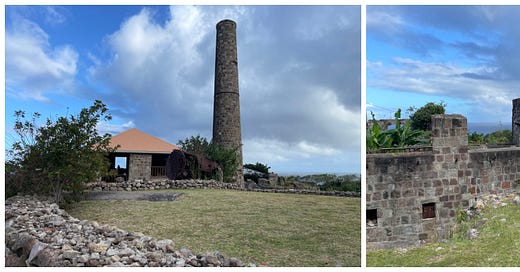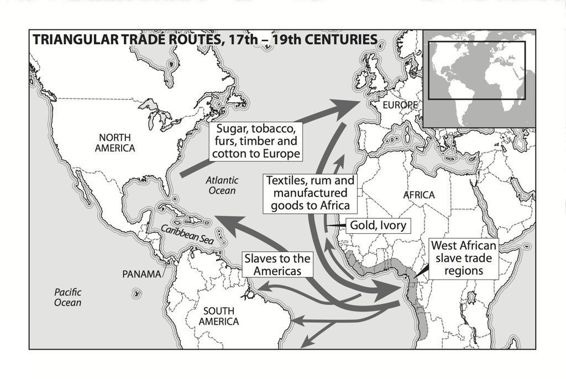Sugar and New World Colonies
Enslavement powered economic and industrial growth in the West Indies
We in America learn very little about sugar’s impact on the colonization of West Indian Islands and the growth of economic power . Our education usually encompasses a bit of discussion of the triangular trade routes that took slaves to the West Indies, then rum and sugar from the West Indies to America, then raw materials to England who sent textiles to Africa. But it does not go much into depth on this.
In traveling to St. Kitts and Nevis I learned there was more to the sotry than we ever heard.
Note: Some of this might “make Caucasian Americans feel bad”, so don’t read it if you are under 18 in South Carolina, Florida or Texas!
Sugar and the New World
Spain opened up much of South America for exploration and exploitation after early voyages. The first major exports / exploitation were riches of gold and silver riches stolen from the native nations. But the entire region held the keys to other riches in agriculture that quickly became apparent. For the American colonies the big exports were tobacco and cotton. But for much of Europe, the real prize was sugar.
Sugar was first raised for export in Brazil by the Portuguese. The Dutch – Portuguese war temporarily put the Netherlands in charge of northern portions of Brazil. This enabled the Dutch to grow sugar in the region near Recife. During the 20 years of Dutch occupation, the Dutch used the slaves brought over by the Portuguese. To run the plantations, they depended on the expertise of local Sephardic Jews recently forced to convert to Christianity due to the Portuguese Inquisition. The Dutch were more tolerant of Jews, and when the Portuguese pushed the Dutch out of Brazil, the Jewish people followed them. The knowledge and management of sugar plantations in Dutch, and later English, colonies was provided by these men.
Sugar changed the Caribbean islands for the worse. Western exploration brought new diseases that wiped out most of the native peoples. This left much of the islands in the region depopulated enough for Europeans to easily take over the islands. The demand for sugar resulted in multiple European powers vying for territory. The French, British, Spanish, Danish, and Dutch divided up islands and set up sugar plantations.
Slavery
Sugar production was extremely labor intensive. Because the native population had largely succumbed to illness and death from contact, new workers had to be brought in. The colonial rulers depended on slave labor brought from Africa as the source of cheap labor. You can see the use of slave labor if you look at the major Atlantic slave-trading nations and the massive number of slaves brought from Africa. Over 10 million slaves were brought to the Americans. Millions more were born into slavery. The major exploiters of slaves were (in order): Portugal, Britain, France, the Netherlands, Spain, USA, and Denmark.
Sugar was not the only crop that utilized slaves, in the US slaves were imported to work cotton and tobacco plantations, but Sugar Plantations were the biggest users of slave labor.
Later innovations boosted production with advanced mills, water power and better machinery over time, but even with new innovations, plantations were still very dependent on slave labor.
Economics of Sugar
Sugar production was extremely profitable in the Caribbean. Before the colonies in the Caribbean, sugar was a very expensive and rarely obtained luxury item. With the advent of Caribbean plantations, sugar consumption soared. For example, sugar consumption in Britain grew from 4 pounds per person in 1700 to 18 pounds in 1800, to 36 pounds by 1859 and over 100 pounds per person by 1900. This sounds a bit extreme, until you recognize that sugar is used in chocolates, jam, confectionaries, and for the British, tea.
The ever growing demand for sugar brought prosperity to the sugar plantation owners. By 1750 sugar was the most valuable commodity in European Trade, 80% of it from French and British Caribbean territories. It brought great wealth to producers and traders.
Not only was sugar proved valuable in and of itself, but the “waste” was used to make rum, also a valuable export. The wealth from this production was massive, albeit little of it passed back to the colonies.
Ecological Impact
Sugar depletes the soil much more quickly than other crops. As more and more of the islands were cleared for sugar, the soils turned poorer and poorer in terms nutrients. The industry essentially used up the nutrients in one place before decamping to a newer location.
You can see the worst impacts of this on many islands, particularly Nevis – where sugar farming burned out the soil and cleared the island of trees, which were used either for plantation construction or cleared to allow more room for sugarcane.
The End of the Boom
Like most booms, the sugar boom in the West Indies ended in a bust. Sugar production in the new world declined to almost nothing due to a few issues. Sugar production’s dependence slave labor made sugar less profitable as slavery was abolished – which happened at different times for different islands. At the same time, other European nations hastened to find sources not controlled by the French, English or Dutch.
At the end of the 1700s, German inventors devised a method to pull sugar out of sugar beets. This innovated use of sugar beets competed with cane sugar. Sugar beets were hardier and could bed planted in temperate and cold climates. Sugar beets upset the monopoly on sugar production from the Caribbean. The use of sugar beets gained traction with uprisings in the colonies, which were difficult and costly to put down. The most famous was the slave revolt in French “Saint-Domingue” which established the nation of Haiti. France turned almost fully to sugar beet consumption after the Haiti slave revolt and the subsequent blockade of Napoleon’s France by the British.
After the end of slavery, many plantations turned to indentured labor. But the sugar beet industry simple outproduced the sugar cane industry. By the end of the 1800s, 2/3s of the world’s sugar production came from sugar beets, which have a much larger possible range of cultivation.
Legacy
The legacy of the sugar boom in the Caribbean is hard to miss. On most of the islands, the lowlands have been denuded for sugar cane and secondary growth is limited. The diversity of the island’s ecosystems have been destroyed which leads to a lack of habitat for indigenous animals.
The population of most Caribbean islands is now made up of descendants of slaves. Many of these slaves were simply left on the islands as the plantation owners left. They were left without infrastructure, schools, and basic governments designed for people.
On most of these islands, tourism is now the primary economic driver. Tourism is a profitable sector, but a destination can fall out of favor quickly. Tourism might fall during international recessions and did crater with Covid. Covid reduced local wealth across the region and is only now returning.
Modern tourism dollars are often used to diversify an island’s economy to insure a “sugar bust” or “tourist bust” doesn’t fatally harm their economy.




